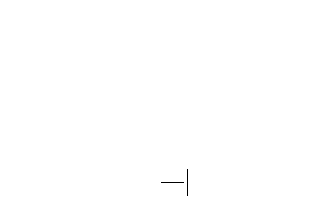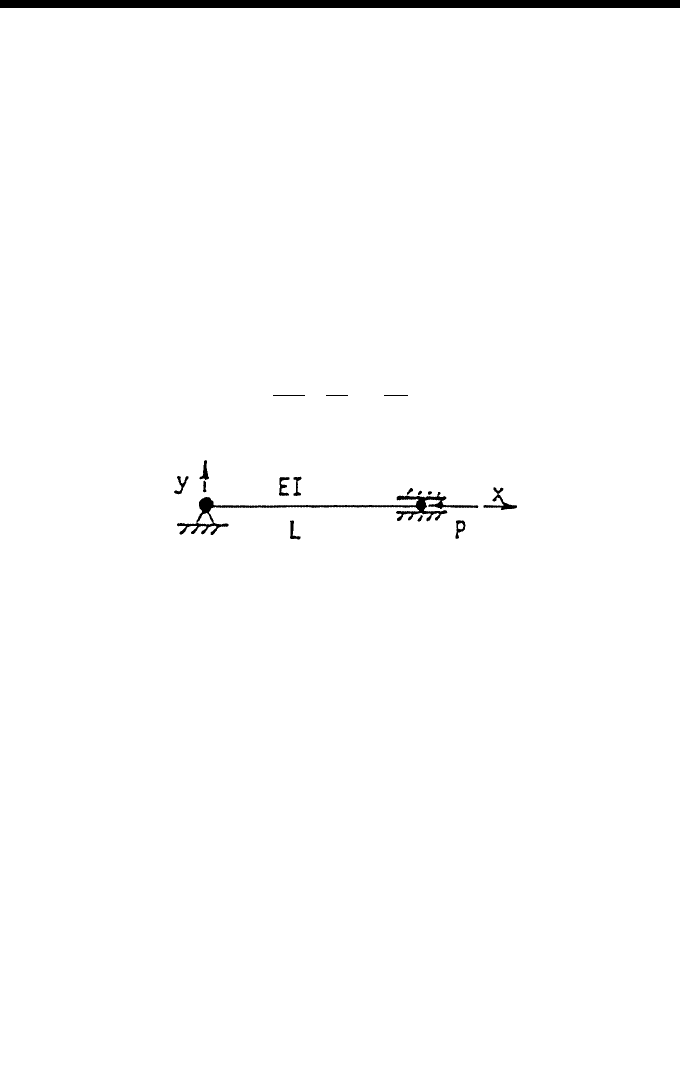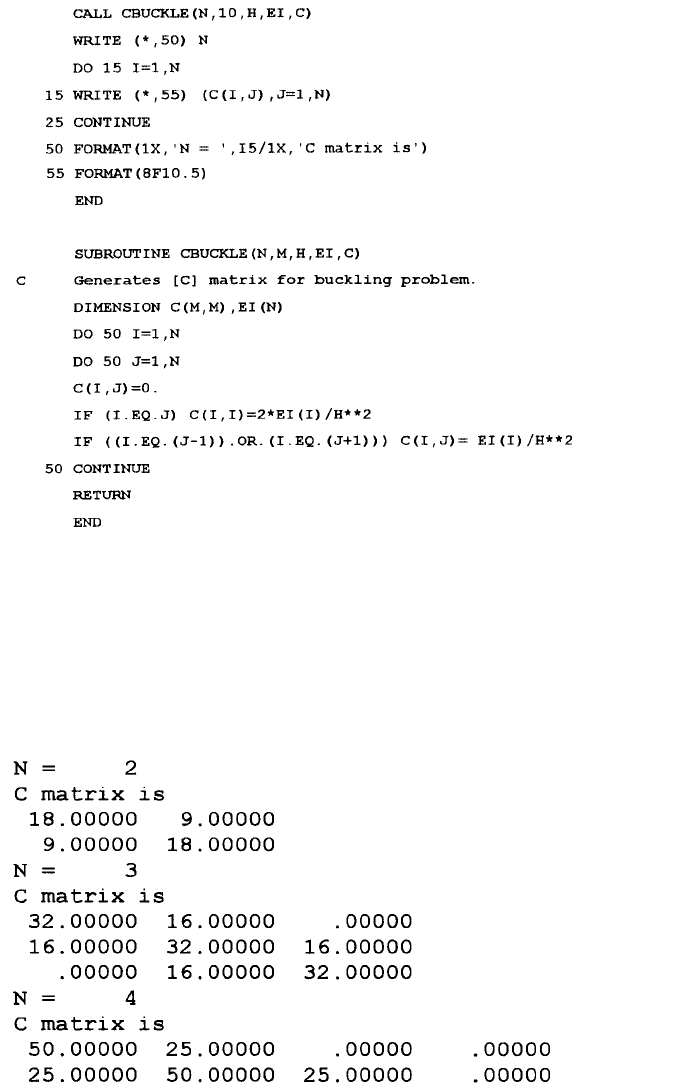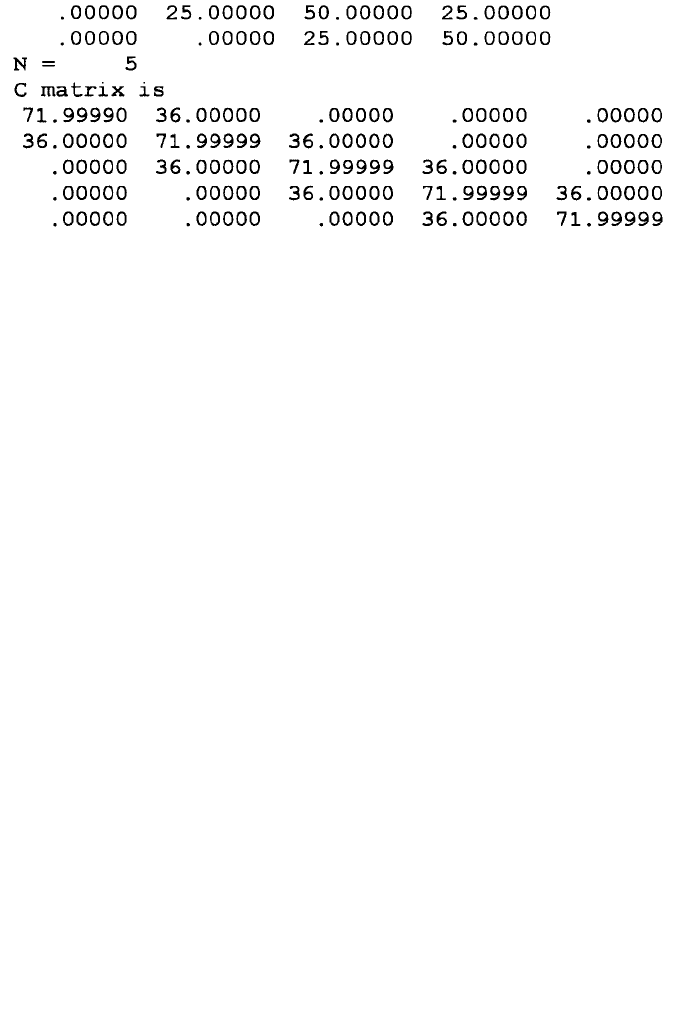Pao Y.C. Engineering Analysis: Interactive Methods and Programs with FORTRAN, QuickBASIC, MATLAB, and Mathematica
Подождите немного. Документ загружается.


© 2001 by CRC Press LLC
(a)
where w is the weight per unit length and T
x
is the horizontal, x-component
of the tension of the cable. Equation (a) is for the case when both w and
T
x
are constant throughout the cable. In fact, Equation a is the solution
of the differential equation:
9
(b)
where s is a variable along the length of the cable. To solve this problem
by applying the Runge-Kutta method, we introduce the slope variable,
= θ dy/dx and convert Equation (b) to form the system of first-order
differential equations dy/dx = f
1
(x) and d/dx = f
2
(x) where f
1
(x) = and
f
2
(x) = w[1 + θ
2
]
1/2
/T
x
. Let w = 0.12 KN/m, x
A
= y
A
= 0, x
B
= 200 m, and
y
B
= 50 m and let the initial conditions be y = = 0 at x = x
A
= 0, iterate
T
x
value until y
B
is within 99.9% of 50 m.
5. Actually, the value of T
x
in Problem 4 can be obtained by solving the
transcendental equation (a) for y = y
B
= 50, x = x
B
= 200, and w = 0.12.
Select a method in the program FindRoot to find this value.
6. How could Problem 4 be solved if x
A
= –100 m and y
A
= 25 m by
application of the Runge-Kutta method (w remains equl to 0.12 KN/m)?
7. Apply MATLAB to solve Problem 2.
8. Apply MATLAB to solve Problem 4 by using an increment of x = 2 m.
9. Apply Mathematica to solve Problem 2.
10. Apply Mathematica to solve Problem 4 using an incremwnt of x = 2 m.
ODEBVPFD
1. The deflection y(x) of the beam shown in Figure 2 can be solved from
using the moment equation, Equation 13 instead of Equation 16, but the
moment M needs to be expressed in terms of x. A similar matrix equation
[C]{Y} = {R} should be derived using only two boundary conditions y =
0 at x = 0 and x = 3L instead of the four boundary conditions specified
in (17). Using the second-order, central-difference formula for d
2
y/dx
2
,
derive the formulas for calculations of the elements of [C] and {R}.
2. Based on the results of Problem 1, proceed to prepare the subprogram
functions CIJ and RI and solve for {Y}. Using the data presented in the
sample application of the QuickBASIC version of program OdeBvpFD,
compute {Y} and compare the two approaches.
3. Following the illustrative example, run the QuickBASIC version of pro-
gram OdeBvoFD for the beam problem shown in Figure 2 but for N equal
to 19, 29, 59, 99, and 119.
y
T
w
wx
T
x
x
=−
cosh 1
dy
dx
w
T
ds
dx
w
T
dy
dx
xx
2
2
2
12
1==+

© 2001 by CRC Press LLC
4. Roundoff errors in the Gaussian elimination steps begin to affect the
accuracy of the computed values of the deflection for Problem 3 when
N = 119. Change the program OdeBvpFD into double precision arith-
metics and rerun the case N = 119 and compare the computed y
max
to that
of analytical solution.
5. Make necessary changes in the FORTRAN version of program OdeB-
vpFD to solve Problems 3 and 4.
6. For the second sample problem (deflection of beam, Figure 2), change
the distributed loads to w
m
= 2 and w
e
= 1, and the rigidities to EI
m
= 1
and EI
e
= 0.5 to recalculate the maximum deflection y
max
.
7. Show that for the beam deflection problem shown in Figure 2 when
Equation 13 is approximated by use of second-order, central difference
and by incorporating the boundary conditions y = 0 at x = 0 and x = 3L,
it will lead to the solution of the matrix equation [C]{Y} = {R} where
the elements of [C] and {R} denoted as c
i,j
and r
i
, respectively can be
calculated by the formulas:
(a)
and
(b)
where N is the number of stations between the two supports and x is
the stepsize equal to 3L/(N + 1).
8. For Figure 2, if the uniformly distributed loads for the middle and ending
portions are designated as w
m
and w
e
, respectively, derive the expressions
for the internal bending moments in the three portions of the beam, 0≤x≤L,
L≤x≤2L, and 2L≤x≤3L.
9. Prepare subprogram FUNCTIONS CIJ and RI for Problem 8 and find the
deflection vector {Y} by use of either FORTRAN or QuickBASIC
version of the program OdeBvpFD. Select appropriate values for the
number of stations N so that the results obtained by this second-order
approach can be compared to those by the fourth-order approach.
10. Use the central finite-difference method and an increment of x = 1 to
find the y values at x = 1 and x = 2 when y is governed by the equation
d
2
y/dx
2
+ 3dy/dx – y = 2x – 3 and satisfies the boundary conditions y =
0 at x = 0 and x = 3.
11. Use the central finite-difference method and an increment of x = 1 to
find the y values at x = 1 and x = 2 when y is governed by the equation
d
2
y/dx
2
+ 3y = x–1 and satisfies the boundary conditions y = 0 at x = 0
and x = 3.
c for i N
c c for i N
c
ii
ii i i
ij
,
,,
,
, ,,,
, ,,,
,
=− = …
== =…−
=
++
212
1121
0
11
elsewhere
rx
M
EI
at x
ii
=
()
∆
2
© 2001 by CRC Press LLC
12. It is known that u = 0 at r = 2 and r = 5 and that for 2<r<5 u satisfies the
equation d
2
u/dr
2
– rdu/dr = –3, use central differences to approximate both
the first and second derivatives of u and an increment of r equal to 1 and
then derive two equations relating the u values at r = 3 and r = 4 and solve
them.
13. Apply MATLAB to solve Problem 3.
14. Apply MATLAB to solve the cable problem #4 listed under OdeBvpRK
and using an increment of x = 1 m.
15. Apply MATLAB to solve Problem 10 by using an increment of x = 0.05.
16. Repeat Problem 13 except by application of Mathematica.
17. Repeat Problem 14 except by application of Mathematica.
18. Repeat Problem 15 except by application of Mathematica.
6.6 REFERENCES
1. C. R. Wylie, Jr., Advanced Engineering Mathematics, McGraw-Hill, New York, 1960,
Chapter 6.
2. J. Water, “Methods of Numerical Integration Applied to System Having Trivial
Function Evaluation,” ACM Communication, Vol. 9, 1966, p. 293.
3. A. Higdon et al., Mechanics of Materials, John Wiley & Sons, New York, 1985,
Chapter 7.
4. Y. C. Pao, Elements of Computed-Aided Design and Manufacturing, CAD/CAM, John
Wiley & Sons, New York, 1984.
5. A. Higdon, E. H. Ohlsen, W. B. Stiles, J. A. Weese, and W. F. Riley, Mechanics of
Materials, 4th Edition, John Wiley & Sons, New York, 1985.
6. W. Jaunzemis, Continuum Mechanics, MacMillan, New York, 1967, p. 365.
7. S. Timoshenko and D. H. Young, Elements of Strength of Materials, 5th Edition, Van
Nostrand Reinhold Co., New York, 1968.
8. W. Jaunzemis, Continuum Mechanics, MacMillan, New York, 1967, p. 365.
9. J. L. Meriam and L. G. Kraige, Engineering Mechanics, Volume One: Statics, Third
Edition, John Wiley & Sons, Inc., New York, 1992.

7
© 2001 by CRC Press LLC
Eigenvalue and
Eigenvector Problems
7.1 INTRODUCTION
There is a class of physical problems which lead to a governing ordinary differential
equation containing an unknown parameter. As an example, consider the buckling
of a slender rod subjected to an axial load P shown in Figure 1. The deflected shape
y(x) is governed by the equation:
1
(1)
where EI is the rigidity and M is the internal bending moment (in this case equal
to -Py) of the rod at the section x. If the rod is supported at both ends such that the
boundary conditions are:
(2)
The unknown parameter appearing in Equation 1 is P which is the load axially
applied causing the rod to buckle. The problem is then to find P and the corresponding
buckled shape y(x). If the value of EI is a constant for all x, this problem can be
solved analytically. The buckling load can be shown to be P =
2
EI/L
2
. For the
general case when EI is the function of x, numerical method has to be applied to
obtain approximate solutions.
In this chapter, we will apply the finite-difference approximation to solve Equa-
tion 1. As will be presented in Section 7.2, the resulting matrix equation involving
the buckled shape evaluated at N selected stations between the end supports of the
rod will be of the standard form:
(3)
FIGURE 1.
The buckling of a slender rod subjected to an axial load P.
dy
dx
M
EI
Py
EI
2
2
==−
yx yx L=
()
==
()
=00
AIY orAY Y
[]
−
[]
()
{}
=
{}
[]
{}
=
{}
λλ0 , ,

© 2001 by CRC Press LLC
where the matrix [A] will depend on the distances between the stations, {Y} contains
the buckled amount of the rod at the stations, and
is related to the unknown
buckling load P. Equation 3 can be interpreted as knowing a matrix [A] and trying
to find a proper vector {Y} when it is multiplied by [A], a scaled {Y} will result.
This becomes the well-known eigenvector and eigenvalue problem because eigen
means proper.
and {Y} in Equation 3 are called the eigenvalue and eigenvector
of [A], respectively. If N is the order of the matrix [A], there are N sets of eigenvalues
and eigenvectors. In Section 7.3, how a polynomial from which all eigenvalues of
a given matrix can be found as roots will be discussed.
As another example of eigenvalue and eigenvector problem, consider the
vibra-
tion
of three masses connected by three springs shown in Figure 2. If any one of
these three masses is subjected to some disturbance such as the case when the mass
m
3
is pulled down by a certain distance and then released, the whole system will
then be vibrating! One will be interested in knowing at what frequency will they be
oscillating up and down. To formulate the analysis, let us denote the displacements
of the masses as x
i
(t) for i = 1 to 3 which are functions of time t. If the elastic
constants of the three springs are denoted as k
i
for i = 1,2,3, it can be shown
2
by
application of the Newton’s laws of motion that the governing differential equations
for the displacements are:
(4)
FIGURE 2.
Another example of eigenvalue and eigenvector problem — the
vibration
of
three masses connected by three springs.
m
dx
dt
kkxkx
1
2
1
2
12122
0++
()
−=

© 2001 by CRC Press LLC
(5)
(6)
If we assume that the masses are vibrating sinusoidally with a common frequency
but with different amplitudes C
i
, their displacements can then be expressed as:
(7)
Substituting Equation 7 into Equations 4 to 6, we obtain:
and
In matrix form, the above equations can be written as:
(8)
Since the amplitudes C
1–3
and sin
ω
t cannot be equal to zero which would have
led to no motion at all, this leaves the only choice of requiring that the coefficient
matrix be singular. In other words, its determinant must be equal to zero. The
resulting equation is a cubic polynomial and enables us to solve for three roots which
are the squared values of the frequencies (
2
) of the vibrating system. For each
frequency, we next need to know the associated amplitudes of the vibration. Equation
8 can be arranged into the standard form, Equation 3 by letting {Y} = [C
1
C
2
C
3
]
T
and:
(9,10)
This example shows that the governing ordinary differential Equations 4 to 6
may not involve with an unknown parameter as in the buckling problem, but once
m
dx
dt
kx k k x kx
2
2
2
2
21 2 3 2 33
0−++
()
−=
m
dx
dt
kx kx
3
2
3
2
32 33
0−+=
x t C t for i
ii
()
==sin , ,ω 123
kkm Ckc t
kA k k m A kA t
12 1
2
122
21 2 3 2
2
233
0
0
+−
()
−
[]
=
−++−
()
−
[]
=
ωω
ωω
sin
sin
−+−
()
[]
=kc k m C t
22 3 3
2
3
0ωωsin
kkm k
kkkm k
kkm
C
C
C
t
12 1
2
2
2232
2
3
333
2
1
2
3
0
0
0
0
0
+− −
−+−−
−−
=
ω
ω
ω
ωsin
λω=
[]
=
+
()
−
−+
()
−
−−
2
12 1 21
22 2 3 2 32
33 33
0
0
, A
kkm km
km k k m km
km km

© 2001 by CRC Press LLC
the common frequency
ω
is introduced for the
free vibration
it becomes a standard
eigenvalue and eigenvector problem described by the matrix [A].
Hence, the question becomes how to find the eigenvalues and their associated
eigenvector of a prescribed matrix. The methods of solution are to be discussed in
Sections 7.3 and 7.4 where the programs
CharacEq
and
EigenVec
are introduced.
In Section 7.5, an iterative method for finding the eigenvector when an eigenvalue
of a matrix is provided and program
EigenvIt
also will be presented. Prior to these
discussions, in the next section we will first concern with how the matrices connected
with the buckling and vibration problems are to be derived and demonstrate in
advance how the programs
CharacEq
,
Bairstow
,
EigenVec
, and
EigenvIt
are to
be employed for obtaining the eigenvalues and eigenvectors of these matrices.
7.2 PROGRAMS EigenODE.Stb AND EigenODE.Vib —
FOR SOLVING STABILITY AND VIBRATION PROBLEMS
In order to obtain numerical solution of the buckling load and shape of the rod
shown in Figure 1 in Section 7.1, the central-difference method introduced in
Chapter 4 can be applied to approximate the second derivative term appearing in
Equation 1 there. At a typical location along the rod, say x = x
j
, Equation 1 can be
approximated as:
(1)
where (EI)
j
is the rigidity of the rod at x
j
and y
j
≡
y(x = x
j
) etc. This approach requires
that the rod be investigated at N stations between the two supports which are labeled
as x
0
and x
N + 1
. These stations are equally spaced so that the increment of x (stepsize
h) is simply h =
x = L/(N + 1). As a result of such arrangement, the boundary
conditions previously defined in Equation 2 now become:
(2)
By writing out the equation for the first and last in-between stations, i.e., j = 1
and j = N, based on Equation 1 and the boundary conditions (2), the two simplified
equations are, respectively:
(3)
and
(4)
dy
dx
yyy
h
Py
EI
jjj j
j
2
2
11
2
2
˙
=
−+
=−
()
−+
yy
N01
0==
+
−+
()
+=20
2
1
12
hP
EI
yy
y
hP
EI
y
N
N
N−
+−+
()
=
1
2
20

© 2001 by CRC Press LLC
Also Equation 1 can be rearranged into the form, for j = 2,3,…,N–1
(5)
where (EI)
j
is the rigidity of the beam at the jth station. By multiplying the jth
equation by –(EI)
j
/h
2
for j = 1,2,…,N, Equations 3 to 5 can be further simplified into
the standard matrix form [A–
I]{Y} = {0} where {0} is a null vector of order N,
= P, {Y} = [y
1
y
2
… y
N
]
T
, and [A] = [a
ij
] which for i,j = 1,2,…,N the elements
are to be calculated with the formulas:
(6)
As a simple numerical example, consider the case of EI = 1, L = 1, and N = 2.
We are seeking only the solution of displacements, y
1
and y
2
at two in-between
points since the stepsize h = L/(N + 1) = 1/3. [A] is of order 2 by 2 and having
elements a
11
= a
22
= 18 and a
12
= a
21
= –9 according to Equation 7. The eigenvalues
of [A
λ
I] can be easily obtained to be
λ
1
= 9 and
λ
2
= 27. The exact solution P =
π
2
EI/L
2
in this case is P =
λ
=
π
2
= 9.87, which indicates that
λ
1
is off about 10%
from the exact value. If N is increased to 3, h = 0.25 and the eigenvalues are
λ
1
=
9.4,
λ
2
= 32, and
λ
3
= 54.6. The error in estimating the first buckling load is reduced
to 100x(9.87–9.4)/9.87 = 4.76%.
P
ROGRAM
E
IGEN
ODE.S
TB
Buckling problem belongs to a general class of
stability
problems, for which a
program called EigenODE.Stb is developed to demonstrate how different increments
or different number of stations can be adopted to continue improving the solution
of eigenvalues and eigenvectors with the aid of programs EigenVec, EigenvIt and
Bairstow. The following shows the interactive application of this program.
FORTRAN V
ERSION
y
hP
EI
yy
j
j
jj−+
+−+
()
+=
1
2
1
20
a
EI h for i j
EI h for i j or i j
ij
i
i
=
()
=
−
()
=− =+
2
11
0
2
2
,
,
, elsewhere

© 2001 by CRC Press LLC
Sample Applications
When program
EigenODE.Stb
is run for the buckling problem, the screen will
show the coefficient [C] in the standard eigenvalue problem of the form [A–
I]{Y} =
{0} where the values of the buckled shape y(x) computed in 2, 3, 4, and 5 stations
between the supported ends of the rod are stored in the vector {Y} and
is equal
to the buckling load P. The resulting display is:

© 2001 by CRC Press LLC
To find the eigenvalues of the above listed matrices, program
CharactEq
can
be applied by interactively specifying the elements in these matrices to obtain the
respective characteristic equations as
λ
2
– 36
λ
+ 243 = 0,
λ
3
– 96
λ
2
– 2560
λ
– 16384 = 0,
λ
4
– 200
λ
3
+ 13125
λ
2
– 312500
λ
+ 1953125 = 0, and
λ
5
– 360
λ
4
+ 46656
3
– 2612736
λ
2
+ 5.878656x10
7
λ
– 3.62791x10
8
= 0
The eigenvalues for these equations can be found by application of the program
Bairstow
. The sets of eigenvalues for the first three equations are (9 and 27), (9.3726,
32, and 54.627), and (9.5492, 34.549, 65.451, and 90.451). The smallest eigenvalue
in magnitude found for the fourth equation is 9.64569. It indicates that if the rod is
partitioned into finer and finer increments, the numerical solution continue to
improve in predicting the first buckling load from 9, 9.3726, 9.5492, to 9.64569 and
converging to the exact value of P =
=
2
= 9.8696. For further improvement, the
derivation of the characteristic equations of order 6 and higher is given as a home-
work problem for the reader to practice application of the programs EigenODE.Stb,
CharacEq, and Bairstow.
P
ROGRAM
E
IGEN
ODE.V
IB
For a better understanding of the vibration problem also introduced in
Section 7.1, let us assign values for the spring constants and masses to be k
1
= k
2
=
k
3
= 10 lb/ft and m
1
= m
2
= m
3
= 1 lb-sec
2
/ft. The matrix [A] becomes:
Indeed, [A] is singular. The determinant of [A–
λ
I] gives the characteristic equa-
tion
3
–50
2
+ 600
–1000 = 0. The roots can be obtained by application of the
A
[]
=
−
−−
−
20 10 0
10 20 10
01010
